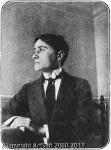Jean Dominique Antony Metzinger
Jean Dominique Antony Metzinger
Style: Cubism;
Place: Nantes
Born: 1883
Death: 1956
Biography:
Jean Dominique Antony Metzinger was a major 20th-century French painter, theorist, writer, critic and poet, who along with Albert Gleizes wrote the first theoretical work on Cubism. His earliest works, from 1900 to 1904, were influenced by the Neo-impressionism of Georges Seurat and Henri-Edmond Cross. Between 1904 and 1907 Metzinger worked in the Divisionist and Fauvist styles with a strong Cézannian component, leading to some of the first proto-Cubist works.
From 1908 Metzinger experimented with the faceting of form, a style that would soon become known as Cubism. His early involvement in Cubism saw him both as an influential artist and an important theorist of the movement. The idea of moving around an object in order to see it from different view-points is treated, for the first time, in Metzinger's Note sur la Peinture, published in 1910. Before the emergence of Cubism, painters worked from the limiting factor of a single view-point. Metzinger, for the first time, in Note sur la peinture, enunciated the interest in representing objects as remembered from successive and subjective experiences within the context of both space and time. Jean Metzinger and Albert Gleizes wrote the first major treatise on Cubism in 1912, entitled Du "Cubisme". Metzinger was a founding member of the Section d'Or group of artists.
Metzinger was at the center of Cubism both because of his participation and identification of the movement when it first emerged, because of his role as intermediary among the Bateau-Lavoir group and the Section d'Or Cubists, and above all because of his artistic personality. During the First World War Metzinger furthered his role as a leading Cubist with his co-founding of the second phase of the movement, referred to as Crystal Cubism. He recognized the importance of mathematics in art, through a radical geometrization of form as an underlying architectural basis for his wartime compositions. The establishing of the basis of this new perspective, and the principles upon which an essentially non-representational art could be built, led to La Peinture et ses lois (Painting and its Laws), written by Albert Gleizes in 1922–23. As post-war reconstruction began, a series of exhibitions at Léonce Rosenberg's Galerie de L'Effort Moderne were to highlight order and allegiance to the aesthetically pure. The collective phenomenon of Cubism—now in its advanced revisionist form—became part of a widely discussed development in French culture, with Metzinger at its helm. Crystal Cubism was the culmination of a continuous narrowing of scope in the name of a return to order; based upon the observation of the artist's relation to nature, rather than on the nature of reality itself. In terms of the separation of culture and life, this period emerges as the most important in the history of Modernism.
For Metzinger, the classical vision had been an incomplete representation of real things, based on an incomplete set of laws, postulates and theorems. He believed the world was dynamic and changing in time, that it appeared different depending on the point of view of the observer. Each of these viewpoints were equally valid according to underlying symmetries inherent in nature. For inspiration, Niels Bohr, the Danish physicist and one of the principle founders of quantum mechanics, hung in his office a large painting by Metzinger, La Femme au Cheval, a conspicuous early example of 'mobile perspective' implementation (also called simultaneity).
Jean Metzinger came from a prominent military family. His great-grandfather, Nicolas Metzinger (18 May 1769 – 1838), Captain in the 1st Horse Artillery Regiment, and Chevalier of the Legion of Honour, had served under Napoleon Bonaparte. A street in the Sixième arrondissement of Nantes (Rue Metzinger) was named after Jean's grandfather, Charles Henri Metzinger (10 May 1814 – ?). Following the early death of his father, Eugène François Metzinger, Jean pursued interests in mathematics, music and painting, though his mother, a music professor by the name of Eugénie Louise Argoud, had ambitions of his becoming a medical doctor. Jean's younger brother Maurice (born 24 Oct. 1885) would become a musician, excelling as a cellist. By 1900 Jean was a student at Académie Cours Cambronne in Nantes, working under Hippolyte Touront, a well-known portrait painter who taught an academic, conventional style of painting. Metzinger, however, was interested in the current trends in painting.
Metzinger sent three paintings to the Salon des Indépendants in 1903, and subsequently moved to Paris with the proceeds from their sale. From the age of 20, Metzinger supported himself as a professional painter. He exhibited regularly in Paris from 1903, participating in the first Salon d'Automne the same year and taking part in a group show with Raoul Dufy, Lejeune and Torent, from 19 January-22 February 1903 at the gallery run by Berthe Weill (1865–1951), with another show November 1903. Metzinger exhibited at Berthe Weill's gallery 23 November-21 December 1905 and again 14 January-10 February 1907, with Robert Delaunay, in 1908 (6–31 January) with André Derain, Fernand Léger and Pablo Picasso, and 28 April-28 May 1910 with Derain, Rouault and Kees van Dongen. He would show four more times at Weill's gallery, 17 January-1 February 1913, March 1913, June 1914 and February 1921. It is at Berthe Weill's that he would meet Max Jacob for the first time. Berthe Weill was also the first Parisian art dealer to sell works of Picasso (1906). Along with Picasso and Metzinger, she helped discover Matisse, Derain, Amedeo Modigliani and Utrillo.
More...
Wikipedia link: Click Here














